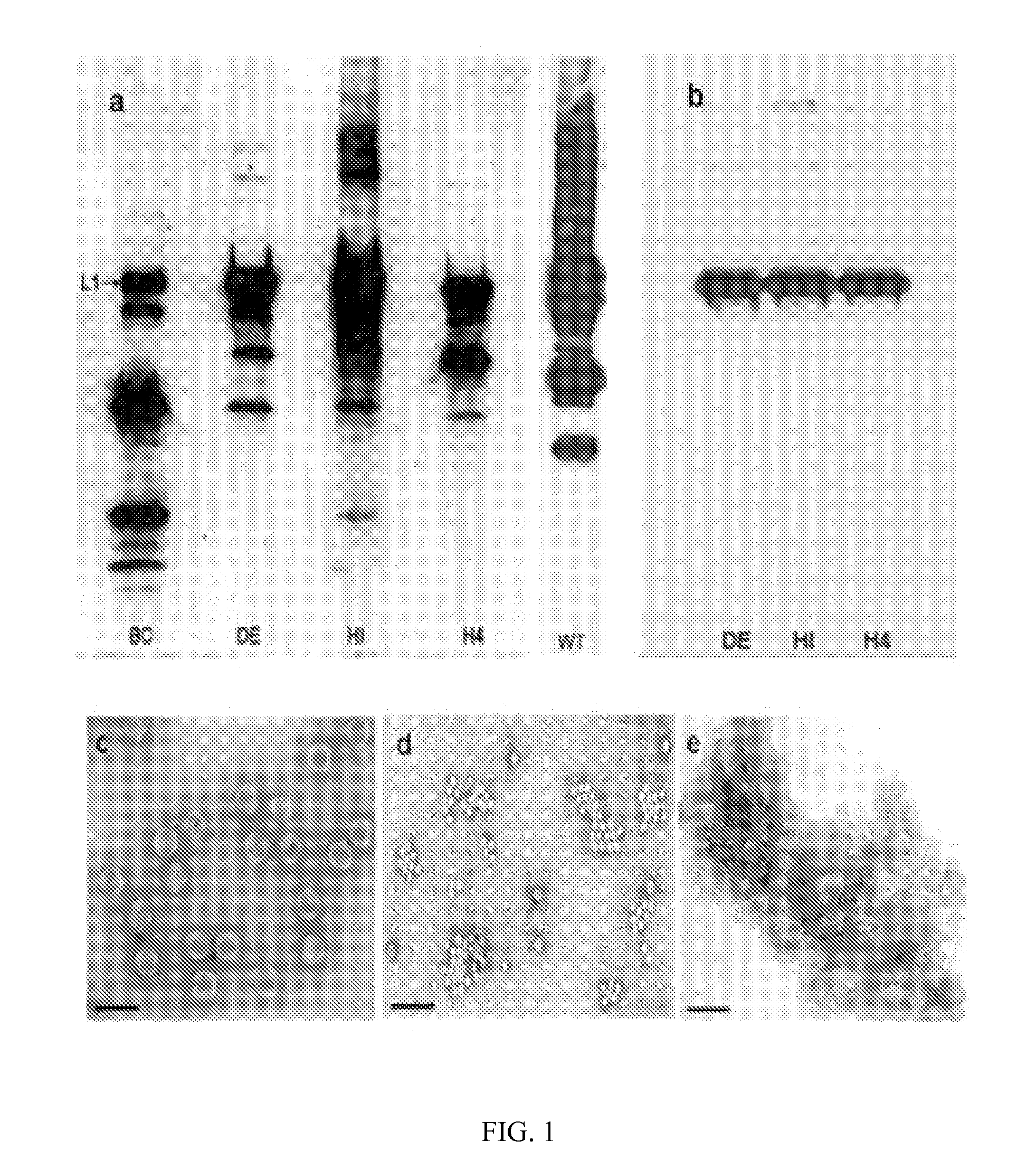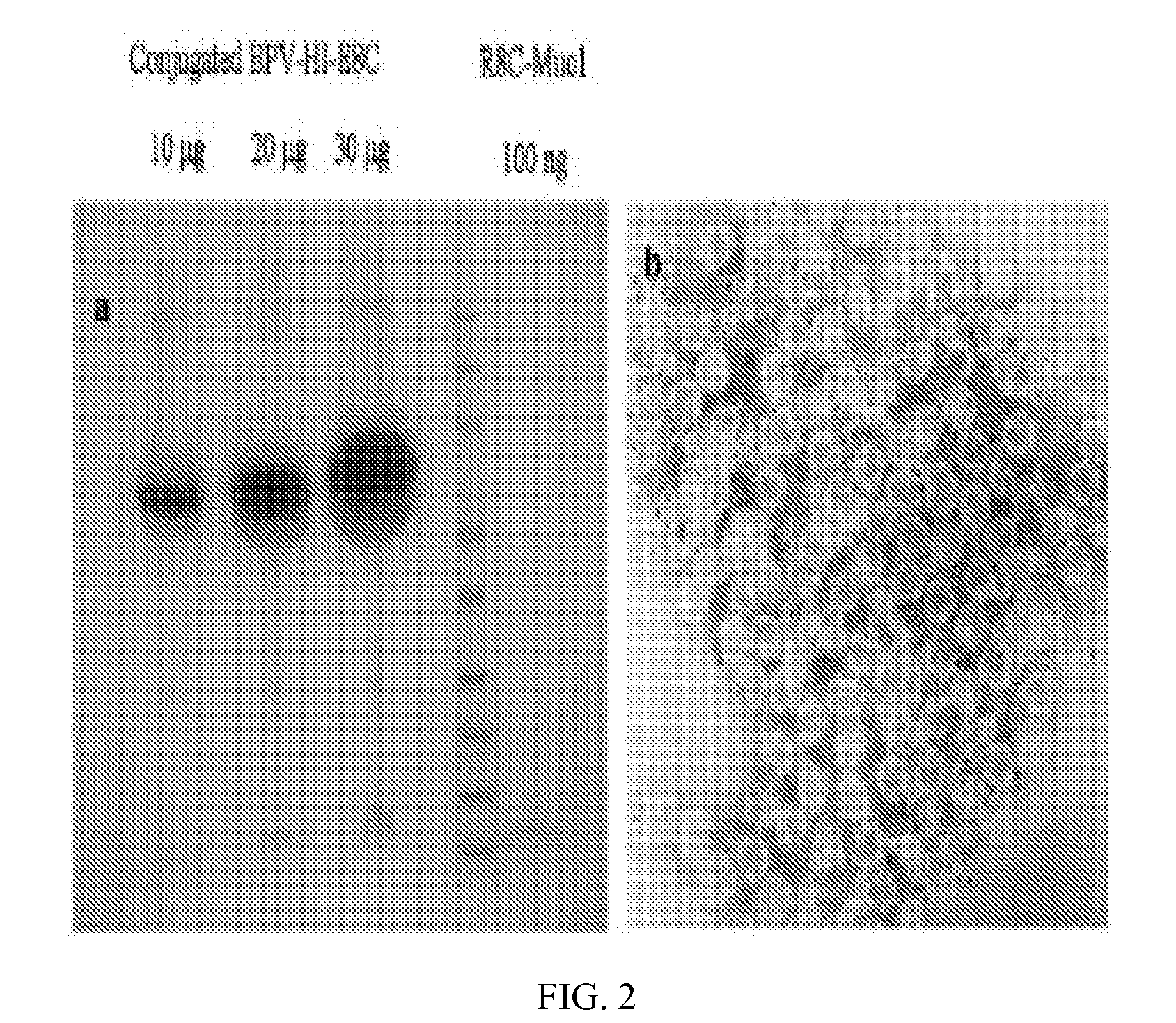Polyionic papilloma virus-like particle (VLP) vaccines
a technology of polyionic papilloma virus and vaccine, which is applied in the field of vaccines, can solve the problems of limit the size and nature of the epitopes that can be inserted into vlps
- Summary
- Abstract
- Description
- Claims
- Application Information
AI Technical Summary
Benefits of technology
Problems solved by technology
Method used
Image
Examples
example 1
Production of Polyanionic BPV Chimeric VLPs
[0128]In the present study, recombinant baculoviruses expressing chimeric BPV L1 protein with insertion of a polyglutamic cysteine peptide and replacement of native residues in the BC, DE and HI loops and the H4 helix respectively were generated. Western blot analyses of lysates from Hi5 cells infected with the baculoviruses revealed different patterns of expression for the L1 protein (FIG. 1A). The BPV-BC-E8c baculovirus construct displayed extensive degradation of L1; the H4 had moderate degradation, while degradation of L1 in the BPVDE-E8c and BPV-HI-E8c was minimal. Large scale infections of insect cells with the four recombinant baculoviruses, and subsequent purification in step gradients revealed different banding patterns for the four constructs. For the BPV-BC-E8c preparation, no L1 reactivity (by Western blot) was observed anywhere in the gradient, suggesting no particle assembly. The majority of the L1 reactivity in the BPV-H4-E8c...
example 2
Conjugation of Purified VLPs and Capsomeres with the R8C-MUC1 Peptide
[0129]Based on SDS-PAGE and electron microscopy, particle preparations were more than 90% pure. Therefore, the amount of particles (in μg of protein) was assumed to represent the amount of L1 protein. L1 is composed of 495 aa with a theoretical MW of 55.56 kd, while the 32-mer peptide has a theoretical MW of 3.44 kd. A 16:1 L1 / peptide mass ratio was therefore assumed to represent a 1:1 molar ratio. A peptide / L1 molar ratio of greater than 2:1 resulted in substantial aggregation of particles, and subsequent conjugation reactions utilized that ratio which is equivalent to 1 μg of peptide for every 8 μg of purified particles. The effect of ionic strength and the ratio of oxidized / reduced glutathione (GSSG:GSH) in the conjugation reaction was also optimized. The conjugation efficiency, as estimated by the amount of MUC1 reactivity in ELISA assays, was substantially inhibited at NaCl concentrations greater than 150 mM, ...
example 3
Differential Ability of MUC1-Conjugated Chimeric VLPs and Capsomeres to Activate Dendritic Cells (DC)
[0130]Native papillomavirus VLPs are known to activate DC. To determine whether chimeric VLPs and capsomeres retain this property, bone marrow-derived DC were exposed to the chimeric constructs and assessed for increased expression of several DC activation and maturation markers. Immature BMDC were left untreated, or loaded with 250 ng of the 20aa MUC1 free peptide, 5 μg of the various BPV particles without MUC1 or conjugated to MUC1, and wild type BPV. Twenty-four hours later, DC were stained with a monoclonal antibody specific for CD11c, a DC specific marker, and with antibodies specific for activation / maturation markers CD40, CD86, CD80 and MHC Class II and analyzed by flow cytometry. Robust upregulation of costimulatory molecules on DC was seen following treatment with WT BPV (FIG. 3A). The BPV-HI-E8c (unconjugated) and BPV-HI-E8c-MUC1 (conjugated) VLPs retained the ability to si...
PUM
| Property | Measurement | Unit |
|---|---|---|
| size | aaaaa | aaaaa |
| diameter | aaaaa | aaaaa |
| diameter | aaaaa | aaaaa |
Abstract
Description
Claims
Application Information
 Login to View More
Login to View More - R&D
- Intellectual Property
- Life Sciences
- Materials
- Tech Scout
- Unparalleled Data Quality
- Higher Quality Content
- 60% Fewer Hallucinations
Browse by: Latest US Patents, China's latest patents, Technical Efficacy Thesaurus, Application Domain, Technology Topic, Popular Technical Reports.
© 2025 PatSnap. All rights reserved.Legal|Privacy policy|Modern Slavery Act Transparency Statement|Sitemap|About US| Contact US: help@patsnap.com



